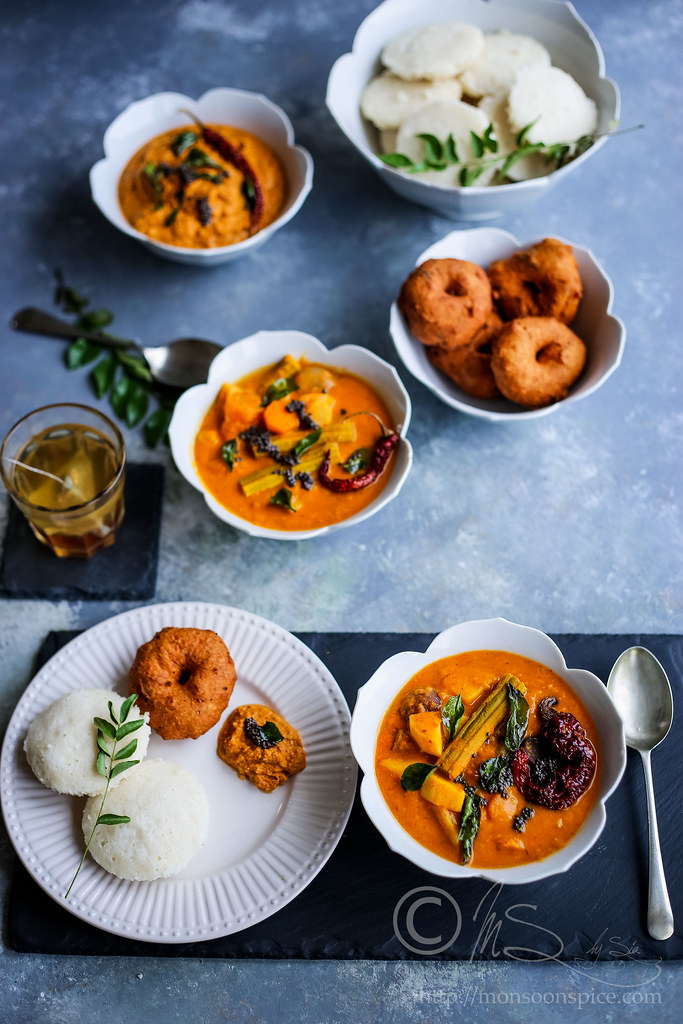
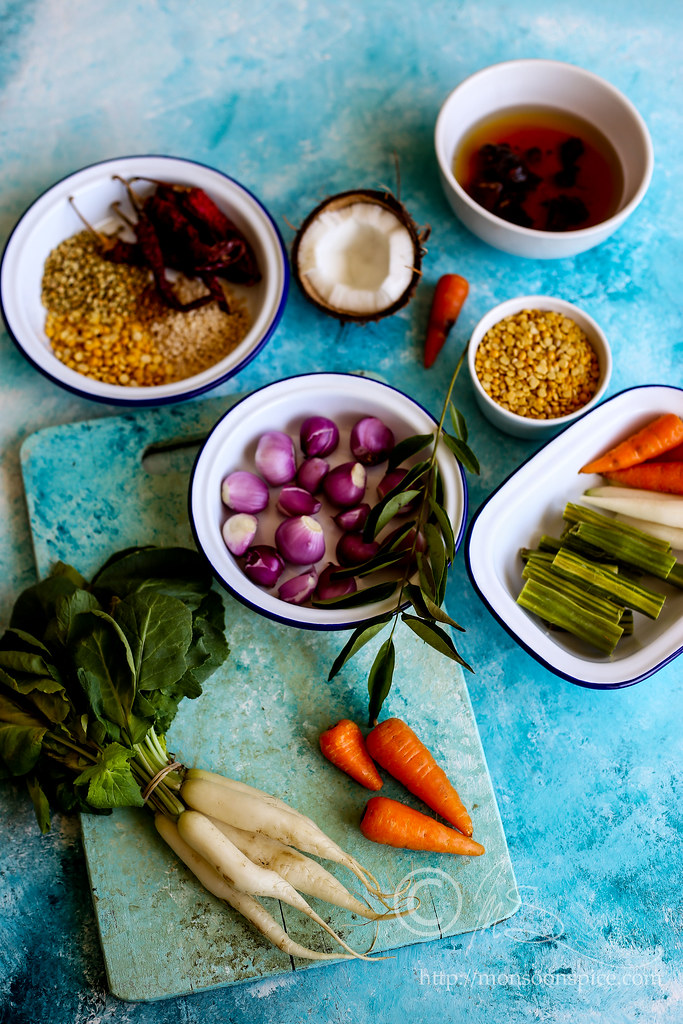
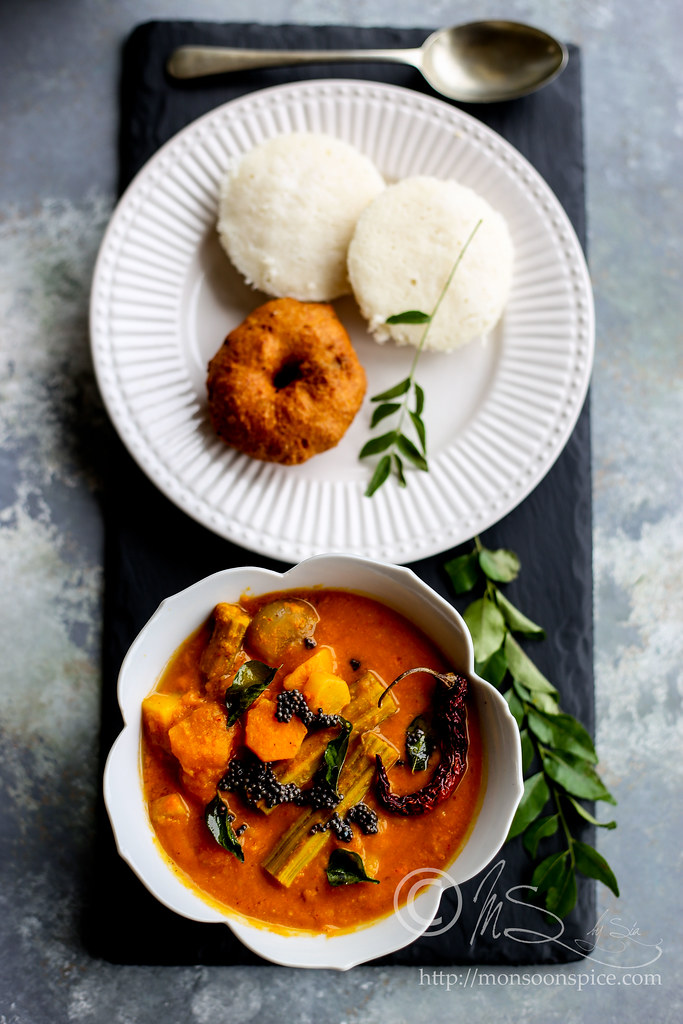






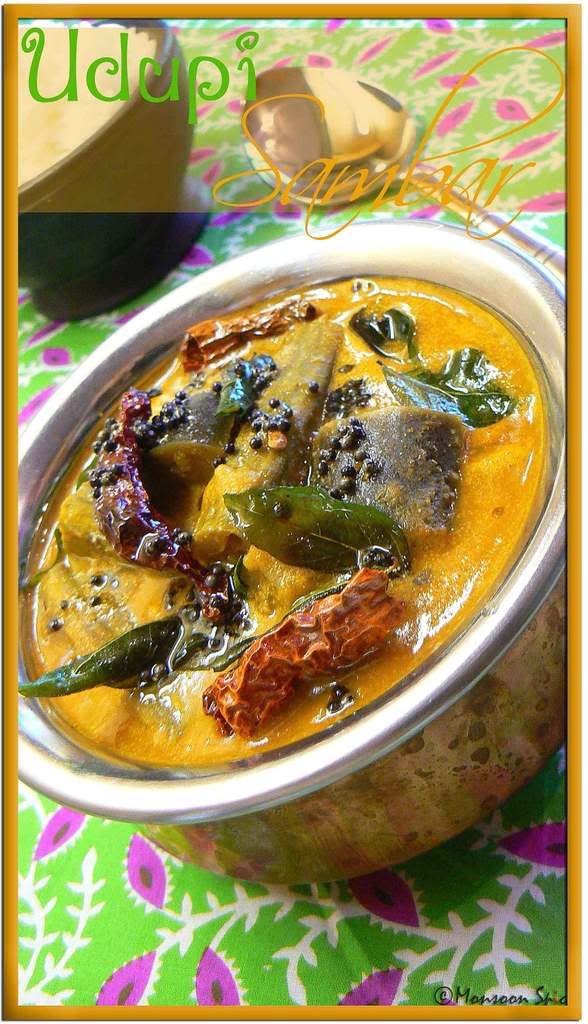
Ingredients:1 large Brinjal/Eggplant, cut into 1 inch cubes (Thai Green Eggplant or Udupi Gulla Badane is preferred)
3-4 Drum Sticks, cut into 2 inch pieces
10-12 small Sambar Onions/Pearl Onions, peeled or 1 large Onion, thinly sliced
2 large Tomatoes, cubed
2-3 Green Chillies, slit
½-¾ cups Toor Dal/Split Pigeon Pea/Red Gram, washed, pressure cooked with pinch of Turmeric Powder and tsp of Oil and mashed well
1 tsp Tamarind Paste/1 small lime sized Tamarind Pulp, soaked in warm water and juice extracted
1 tsp Jaggery (Adjust acc to taste)
½ tsp Turmeric Powder
Small bunch of Coriander Leaves, finely chopped
1 tbsp Oil (Preferably Coconut Oil)
¼ tsp Hing/Asafoetida
Few Curry Leaves
Salt to taste
For Udupi Sambar Powder:
1 tbsp Urad Dal/Split Black Gram
½ tbsp Channa Dal/Spilt Bengal Gram
2 tsp Jeera/Cumin Seeds
1 tbsp Coriander Seeds
½ tsp Methi/Fenugreek Seeds
4-6 Dry Red Chilli (Preferably Byadagi, adjust acc to taste)
1 cup Grated fresh/frozen Coconut
For Tempering:
1 tsp Mustard Seeds
1 Dry Red Chilli, halved
¼ tsp Hing/Asafoetida
Few Curry Leaves
1 tbsp Oil, preferably Coconut Oil

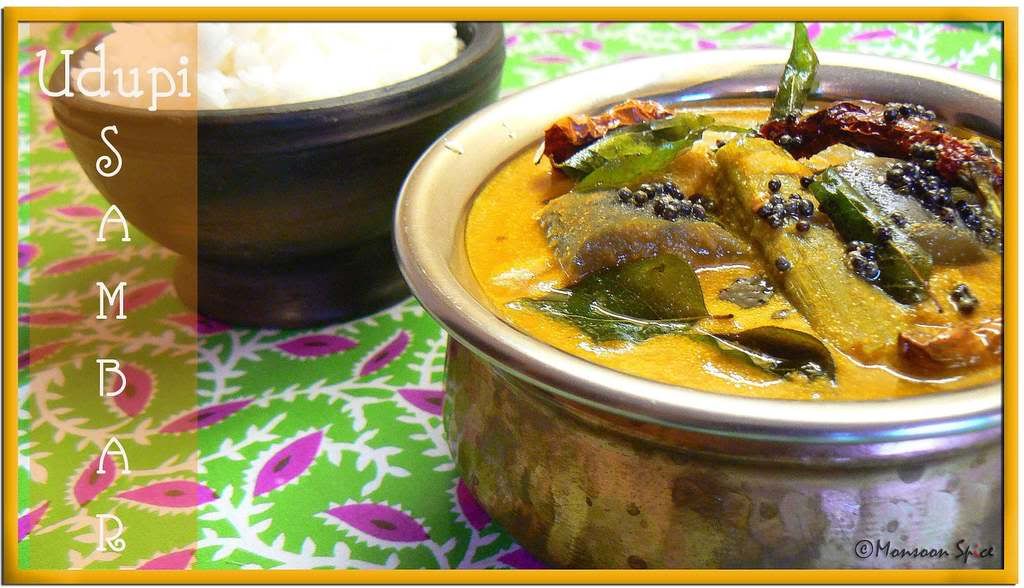
 Akki Pundi served with Potato-Onion Sambar and Onion Pakodas
Akki Pundi served with Potato-Onion Sambar and Onion Pakodas
Ingredients:
2 cups Rice
Salt to taste

Akki Pundi ready for steam cooking
Method:
Wash rice and spread it on clean cloth to dry.
Once all the water is dried up, grind the rice without adding water coarsely. Make sure that you don’t grind it to smooth powdery texture. I usually grind the rice grains to khus-khus sized granules.
In a mean while, pour 3 glasses of water and salt to taste in thick bottomed vessel and bring it to boil.
As soon as the water is hot enough add ground rice and keep mixing the mixture making sure that they don’t stick to the bottom of the pan.
Cook this mixture over a medium flame, stirring continuously till solid enough to be rolled into balls. (It took me around 8-10 minutes)
Make small lemon-sized balls by wetting your hands in cold water.
Arrange them in a steamer and steam cook for about 15 minutes in medium heat.
Let it cool down a bit before you serve them.
Serve them with any Sambar, Kurma, Honey or Chutneys.

 Akki Pundi served with Potato-Onion Sambar and Onion Pakodas
Akki Pundi served with Potato-Onion Sambar and Onion Pakodas
Tips:
Once you mix the hot water and rice flour you can shift the mixture into microwave bowl and cook it in microwave for about 10 minutes. Make sure that you mix the mixture once in every 3 minutes so that it’s mixed evenly.
You can also cook the Pundi’s in microwave for 8-10 minutes using Microwave Idli Maker.
To make spicy Pundi’s, season mustard, urad dal, broken red chillies and curry leaves. Add this seasoning to the water along with rice in the beginning and then proceed with the next steps.
You can also add ½ cup of freshly gated coconut to the mixture.

Akki Pundi served with Potato-Onion Sambar and Onion Pakodas

Idli-Vada-Sambar
Recipe for Idli:
Ingredients:
2 cups of Rice
1 cup Urad Dal
Salt to taste
Method:
Soak rice and urad dal separately in water for 2-3 hours.
First grind the urad dal to smooth paste. Remember that smoother the better.
Then grind rice to a coarse paste. Make sure that you don’t grind rice to smooth paste.
Mix them together adding required salt to slightly thick paste. The batter should be thicker than the dosa batter you prepare.
Keep it covered to ferment for overnight.
Next day pour a ladle of batter into idli maker and steam cook in medium flame for 15-20 minutes till they are done.
Let them cool for few minutes (3-4 minutes) before you take them out. This way the idli will be fluffy and soft.
Serve hot with Coconut Chutney and steaming bowl of Sambar.
Recipe for Vada:
Ingredients:
1 cup of Urad Dal
2-3 Green Chillies, chopped finely
¾ inch Ginger, chopped finely
2 tbsp Coriander Leaves, finely chopped
Salt to taste
Method:
Soak urad dal in water for 1-2 hours.
Grind them coarsely adding very little water. (Little means very little)
Add chopped coriander leaves, ginger, green chillies and salt as required.
Mix them well together with hands. Add little water if required.
Make small lime sized balls and press them slightly using your palm.
With your finger make a small hole in the center.
Deep fry them in hot oil till they turn into lovely golden brown colour.
Serve hot with Coconut Chutney and Sambar. Delicious….
Recipe for Onion Sambar:
Ingredients:
1 cup Small Onions
1/2 cup Thuar Dal/Red gram Dal
1 medium lime sized Tamarind
2 Tomatoes, sliced
2 Green Chillies, slit
Small bunch of Coriander leaves, Chopped finely
2 tsp Oil
Salt to taste
For Seasoning:
1 tsp Oil
1 tsp Mustard
2 Red chillies
1/4 tsp Hing/Asafetida
Few curry leaves
To Roast & Grind:
2 tsp Dhania/Coriander Seeds
11/2 tsp Urad Dal/Black gram Dal
1 tsp Jeera/Cumin Seeds
2 tsp Channa/Bengal gram Dal
4-5 Red Chillies
1/2 tsp Fenugreek Seeds
1 Medium Onion, roughly chopped
1 Tomato, roughly chopped
1/4 cup of Grated Coconut
3 tsp Oil
Method:
Heat 1tsp of Oil and roast the above ingredients until golden.
Fry 1 onion and 1 tomato separately with little oil.
Grind everything with grated coconut to a smooth paste.
Heat Oil in a shallow pan and fry the small onion for 1 to 2 minutes.
Add enough water and boil it till soft.
Cook red gram dal in pressure cooker and mash well.
Mix cooked onion, mashed dal, tamarind extract, tomatoes, green chillies and ground paste with salt and enough water and bring it to boil.
When the sambar is thick enough remove from fire.
Heat oil and add mustard seeds, red chillies, curry leaves and hing.
When mustard starts spluttering add this seasoning to sambar.
Serve hot Sambar garnished with chopped coriander leaves with Rice, Idlis or Dosas.
Final Verdict:
You may be thousands of miles away from your country, but your roots are still deep down in your hometown. You may try different foods from different continents but the one which will always make you smile is the one from your mom’s kitchen. What better example can I give than the simple yet unbeatable taste of Idli-Vada with Sambar!!! Their simplicity takes your breath away and their taste wipes you off your feet, other than your loved one’s charm;) The pleasure you get from this type of dishes is only known when you try it out. It will surely bring back lot of good old memories.
Well… As expected you can never go wrong with Idli-Vadas. If you follow the instructions from your mom, step by step, then you will surely make a soft and fluffy idlis with yummy vadas. And not to forget the million dollar smile from my dear hubby:)

Idli-Vada-Sambar
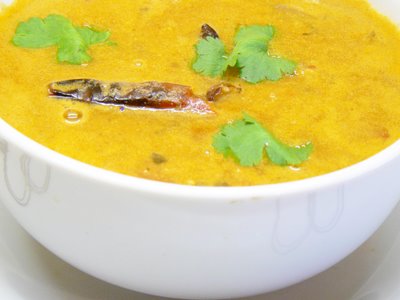 Onion SambarMethod:
Onion SambarMethod: